Neil Koenig, ideaXme interviewer, senior television producer and journalist, interviews Rachel Goslins, Director of the Arts and Industries Building, at the Smithsonian Institution.
What does the Future Mean to You?
What does the future mean to you? A forthcoming exhibition in America’s capital city will attempt to help visitors to answer this question.
The Arts and Industries Building at the Smithsonian
The Arts and Industries Building (AIB) in Washington DC is one of the oldest parts of America’s vast Smithsonian Institution. It originally opened in 1881 as the first national museum in the US. Over the years, millions of visitors have experienced world-changing inventions like the electric light bulb, the steam locomotive and Alexander Graham Bell’s telephone at AIB. After almost a century of showing exhibits such as these, the building’s 100,000 square foot halls closed completely in 2004.
Smithsonian FUTURES Show
AIB will be relaunched soon with a new exhibition, called FUTURES. This multidisciplinary project will feature artefacts drawn from the Smithsonian’s vast collection and research centres, as well as large-scale commissioned artworks and dozens of interactive exhibits, with the aim of “encouraging visitors to embrace their own role in shaping what is to come”.
Imagining the Future
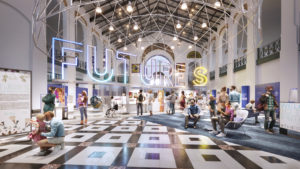
In this ideaXme interview, AIB Director Rachel Goslins talks to journalist and producer Neil Koenig about re-launching a museum in the middle of a pandemic; the wider challenges facing the museum sector; and her goals for the FUTURES show, and the original research under-pinning it, which reveals that what most of us want from the future is “not flying cars and robots” but values like “peacefulness and sustainability”.
RACHEL GOSLINS, FIRST DIRECTOR OF THE ARTS AND INDUSTRIES BUILDING

Rachel Goslins has more than 20 years of experience across the worlds of art, law and public policy. Before her new role as AIB’s Director, Rachel served as Executive Director of the President’s Committee on the Arts and the Humanities, advising the Obama White House on cultural policy from 2009 to 2015. Under her tenure, the Committee spearheaded campaigns of cultural diplomacy and national investment in the arts, including: the Turnaround Arts project, the first federally-led, public-private partnership to introduce arts education programs to low-performing elementary schools, and Film Forward, which recovered and restored Haitian art and artefacts endangered by the 2010 earthquake and its aftermath. Earlier, Rachel founded a documentary production company, directing feature documentaries and working on productions for the Public Broadcasting Service, Discovery Channel, National Geographic Channel and History. She is a 2012 Henry Crown Fellow of the Aspen Institute.
Smithsonian in Partnership with the Rockwell Group
Rockwell Group partnered with the Smithsonian on a cohesive overall guest experience, interior design, exhibition design, wayfinding, and experiential graphics, and technology installations—a total of approximately 32,000 square feet of ground floor exhibition space in the four main halls off the AIB’s central rotunda. LAB at Rockwell Group is creating a touch-free digital ecosystem sponsored by SoftBank that will enhance the storytelling experience for visitors.
Neil Koenig and Rachel Goslins: The Smithsonian FUTURES Show
Neil Koenig Senior TV Series Producer: [00:00:00] Welcome to another episode of the ideaXme show.
The Arts and Industries Building (AIB) in Washington, DC is one of the oldest parts of America’s vast Smithsonian Institution. It will be relaunched soon with a new exhibition about the future. The AIB’s director is Rachel Goslins.
Neil Koenig Senior TV Series Producer: [00:00:18] The Smithsonian is an extraordinary phenomenon. It’s not just a museum, is it? It’s a kind of network of museums and institutions. To those people who might be less familiar with it, perhaps people outside the U.S. – please explain a bit of the background.
Civic Trust in Museums and Belief in the Smithsonian
Rachel Goslins, Director, AIB at the Smithsonian Institution: [00:00:38] Sure. So, the Smithsonian is the largest museum and research complex in the world, and it’s famous for its museums and our incredible collections everything from the Wright Flyer and the Apollo 11 capsule to, you know, Dorothy’s Ruby Slippers and Archie Bunker’s chair. And in addition to our amazing museums, which span natural history, American history, contemporary art, you know, Asian art, African art, everything, really. We also have research centers really all over the world, including a tropical research center in Panama that does a lot of work around climate and sustainability. And an astrophysical observatory in Boston, we were part of the team that took the first picture of the black of a black hole. So, I, you know, the more I, the longer I’m here, the more I discover all of the different things we do, the best thing I think about the Smithsonian, or at least what helps me most in my job is it is just such a beloved and trusted voice. And especially now and especially in America, civic trust is a very scarce resource. People don’t believe government or journalists or think tanks or even universities in the way that they used to. But they still trust museums and they believe the Smithsonian. So, we think a lot about the responsibility and opportunity that that provides us to say things in a way that people across a wide spectrum of geography and demographics and political affiliations will be able to hear.
Neil Koenig Senior TV Series Producer: [00:02:15] Rachel tells us a little bit about yourself and your background.
Rachel Goslins, Director, AIB at the Smithsonian Institution: [00:02:20] It’s a big question. Just a small-town girl trying to make a difference in the world. I came to this job as director of the Arts and Industries, Building through a somewhat peripatetic path. I have done a number of things in my life. I’ve been fortunate to have to work in and around the creative industries for more than 30 years now. I started out as a copyright attorney, did that for about a decade, and then I became a documentary filmmaker, an arts administrator, which I did for another decade, and then was lucky enough to go to the White House under President Obama and run an advisory committee to the president on cultural policy and was able to spend most of both terms doing some exciting and important work there. And then I got asked to join the Smithsonian. So, I have a friend from the South who says when something good happens to them says it’s like I fell into a pool of butter, and I feel like that about a lot of my different professional experiences.
Neil Koenig Senior TV Series Producer: [00:03:18] The Smithsonian was founded in the 19th century, and as you’ve been saying, it’s an extraordinary institution. The Arts and Industries Building, which is one of the buildings on the National Mall complex, is also quite an extraordinary place. Tell us a bit about this this particular building.
Rachel Goslins, Director, AIB at the Smithsonian Institution: [00:03:42] Yeah, this is my favourite subject. Well, no, really like talking about my exhibition, too. So, the Arts and Industries Building is extraordinary in so many ways. Talking about the history of the Smithsonian, it is the second Smithsonian building to be built and the first museum to be built on the National Mall. And it was this fundamental moment for this, as you say, you know, 19th century institution, which up until that point had been primarily kind of a research and grant making institution. And although it had things that people had sent back, researchers had sent back from various places, and they were kind of displaying it in the lobby. The decision to build the Arts and Industries Building was really a moment of inflection for the institution. It was the moment at which the Smithsonian decided to start telling stories as part of its core mission to face outwards. And so, they decided to build the arts and industries building. And the second secretary of the Smithsonian and his head curator, who went on to become the first director of the building, had to figure out what to do.
Rachel Goslins, Director, AIB at the Smithsonian Institution: [00:04:43] How do we build America’s first national museum? And they went to Europe, and they toured the great, you know, museums of Europe, and they made a very conscious decision to build a people’s museum. They didn’t want it to be a white marble palace on a hill. So instead of making it out of white marble and columns, they made it out of this glorious kind of multi-coloured brick. They instead of having a single entrance, they put four entrances at all four compass points to indicate that whoever wanted to, was welcome. And they modelled it after the Great World’s Fair Pavilion, which was, you know, the kind of zeitgeist of how people were thinking of large scale, popular public experiences, thinking about big ideas. So, it has these soaring halls, it’s got more volumetric space than any of our other museums, and it has nine hundred and eighty-four windows. Very different from how we build museums today, but it was built before air conditioning or electricity, so it had to be entirely cooled by the breezes coming off the Potomac and 100 percent day lit.
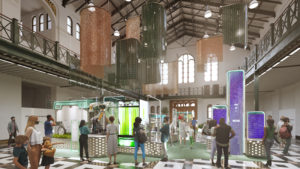
Neil Koenig Senior TV Series Producer: [00:05:52] And maintaining a structure like this is not an easy process. And indeed, extensive work has recently been carried out. But that kind of left you with an empty shell. What happened after that? How did the project that you’re now working on come about?
175th Anniversary of the Arts and Industries Building, the Smithsonian
Rachel Goslins, Director, AIB at the Smithsonian Institution: [00:06:14] Yeah, so you’re exactly right. The building right before I came on as the director of the building had been the building hasn’t been fully renovated in the 175 years it has been in existence. Right before I came on, it had a large structural renovation, so the roof and the brick and the foundations, but the inside is still raw and awaiting a large renovation and sort of permanent reopening. I like to call it industrial chic. It’s a lot of exposed ductwork and peeling paint, but it’s very cool. And so, as we are thinking about, and we are stewarding the long-term plans for the building. In the meantime, we had this building that was safe for people but not conducive to typical museum exhibitions. And we had one hundred and seventy fifth anniversary of the Smithsonian coming up. And so the Smithsonian leadership and I came up with this idea of, you know, for one hundred and seventy fifth anniversary instead of looking backwards, which is often the instinct to look forward and to at this moment in time in particular, it feels really important for institutions like the Smithsonian to help people think about the future and think about how to approach the future, how to acquire vocabulary, even about thinking about the future. Because, you know, the mood is a little dystopian these days and we have a lot of help imagining what could go wrong in the future.
Rachel Goslins, Director, AIB at the Smithsonian Institution: [00:07:38] From media, from public intellectuals, from, you know, Dark Mirror and every science fiction book ever written. But we don’t have as much help imagining what could go right, and it felt to us that this was an equally important conversation to help people have. Because if you can’t figure out where you want to go, you’re not going to know how to get there. And these feelings of sort of overwhelming doom barrelling towards us like a freight train leave people feeling powerless and paralyzed and like they just better buckle in or get out of the way. But the fact is, the future is something we all create collaboratively and by a series of individual and collective decisions. So, we thought, how can we use this glorious space? This year we have where it’s empty and not doing other things and use all the resources of the Smithsonian and all our incredible collections, but also our ability to pull in the most interesting thinkers, inventors, scientists, and artists from all over the world to put on something which is called FUTURES, which is kind of part exhibition, part festival. And really, its mission is to help people think more, hopefully, and flexibly about the future.
Neil Koenig Senior TV Series Producer: [00:08:55] Now you had this idea to do a project looking forward. What was the first step in making this happen? Did you do some research?
Rachel Goslins, Director, AIB at the Smithsonian Institution: [00:09:07] It’s a great question. Yes, we did. We hired this great research team based in London to do both small focus groups for us and a large national survey to try and get a sense of how people were feeling about the future where the delta was between their hopes and their fears and what they would want to see out of a museum exhibition slash festival about the future. And it was so interesting. We learned a lot. We got a lot of great insights out of that. But one of the things that just stuck with me. You know, we asked people: What do you want from the future? And I expected to get, perhaps naively, a bunch of like flying cars and robots that serve me breakfast and 3-D printers. That’ll make me a cappuccino, you know, food printers that’ll make me a cappuccino in the morning.
Neil Koenig Senior TV Series Producer: [00:10:02] I know. Sounds great.
Peacefulness, Sustainability and Equity
Rachel Goslins, Director, AIB at the Smithsonian Institution: [00:10:03] Yes. But across the board, across demographics, age ranges, geographies, what we got was: Peacefulness. Sustainability. Equity. These values, so not things, not objects, not spaceships and furniture that moulded to your body. But people wanted a future that was filled with values, that aligned with what was important to them. And so that was really this pivotal first step in organizing the exhibition because let me just pause for a second. This is a ridiculous folly that we’re doing. We are putting on an exhibition about an impossible subject like the future. That’s like saying: I’m going to do an exhibition about the past, or the present. What does that even mean? So, we’re doing an exhibition about an impossible subject in a broken building that at that point had like four working power outlets on an incredibly short timeline, as a total start up, like starting from scratch in a large, glorious but bureaucratic institution like the Smithsonian.
Rachel Goslins, Director, AIB at the Smithsonian Institution: [00:11:12] So already it was it was a, you know, we knew that this was possibly impossible. But the first thing that we decided to do after we got back this research, we were thinking about how do we organize this exhibition and the typical way to organize an exhibition about the future is by topic, right? Future of transportation, future of food, future of work. And we decided to organize it by values. By what kind of future people want to live in. Not what things do people want in the future? So, we decided to organize it by values and then group the objects around those values.
Past FUTURES
Rachel Goslins, Director, AIB at the Smithsonian Institution: [00:11:50] So the exhibition is organized into four different halls. The first one is past futures, that takes you through kind of a tour of some amazing objects and artifacts from 12 of our different Smithsonian museums that are looking at how we’ve kind of always been inventing the future and what have we gotten right and what have we gotten wrong? And what are the consequences intended or otherwise of choices we’ve made? And then you walk into this amazing central rotunda that has this gorgeous kind of art tech installation, this emotional sculpture by the artist Suchi Reddy that captures your hopes and dreams for the future and turns them into this contributory kind of gigantic floating orb. And then each of the halls is organized by values. So, futures that unite, which talks about futures that are more collaborative, that are more equitable, that are more cooperative. Futures that inspire. So what role does creativity and imagination and science fiction have in creating the future and futures that work, which is an interesting hall because it not only talks about the values of efficiency and going faster and doing more with less, which is what we think of when we think of the future, but also slowness and also sustainability, because a future that works – what does that mean to our visitors to have a future that works? And in that hall, we pose a lot of different questions about what that means to people.
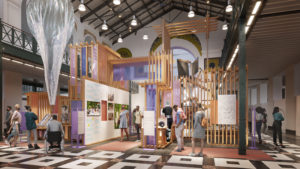
Neil Koenig Senior TV Series Producer: [00:13:18] Of course, you did this research before the devastating outbreak of the pandemic. But one thing that I’ve noticed, certainly in making documentaries in America over the past 20 or 30 years is particularly those that feature subjects relating to technology, is the intense amount of optimism that one finds, particularly amongst entrepreneurs and scientists and technologists, that the future is going to be, it may be challenging, but it’s going to be wonderful. Did that come through in any of your research?
Rachel Goslins, Director, AIB at the Smithsonian Institution: [00:14:09] You know, it’s so interesting. I totally agree what you say. I do think we are and especially, I mean, it’s really a hallmark of the sort of 50s, 60s and 70s this when really this sort of techno optimism was defined and created. And you look at the New York world’s fairs of sixty-four and sixty-five and that’s literally, you know, kind of the defining characteristic of them. I think that that has waned significantly. I mean, probably across the world optimism in general. But here in the States, you know, when we ask people as part of the research, we asked them to send us a picture that represented the future to them. And again, me being naive, I thought I was going to get robots and the Jetsons, you know, title sequence and all that.
Invitation for People to Imagine the Future that they Want
Rachel Goslins, Director, AIB at the Smithsonian Institution: [00:14:56] I did a presentation for a group for our board about this, this research, and I literally teared up when I got to the slide because we put a slide together of all the pictures that people had sent us, and it was like polar bears on a tiny shrinking iceberg. Charlotte, you know, riots, big corporate logos. You know, there was just this sense of paralysis and despair. And if people had to totally encapsulate their vision of the future into one image, they were heart-breaking. And these came from 16-year-olds and 80-year-olds and, you know, and that just reinforced for us that. We have to we have to balance the conversation nationally and internationally, not just everything that could go wrong, but also, you know, so we have to help people imagine not just the future that they fear, but also the future they want. And it really gave added urgency, I think, to our mission. Interesting, the word optimism. We spent a lot of time thinking about the difference between optimism and hopefulness. And so, when we talk about this exhibition, we talk about hopefulness.
Rachel Goslins, Director, AIB at the Smithsonian Institution: [00:16:22] The Smithsonian is a fundamentally optimistic institution. We are constantly telling amazing stories of triumph over adversity and ideas that change the world and people that change the world. I don’t know that we can say to anybody, the future is going to be OK, don’t worry, but we can say there are reasons to be hopeful. And you have to some extent, obviously, none of us the dictator of the world. But you do have the power to make choices that will move the needle towards the future that you want to live in.
Neil Koenig Senior TV Series Producer: [00:16:58] Tell us a little bit about some of the exhibits that people will be able to see. The ones that particularly grab your attention.
Rachel Goslins, Director, AIB at the Smithsonian Institution: [00:17:10] Yeah. It’s a mixture of big, hard science ideas and interesting artists explorations of some of these values and ideas. And the little things that could totally change the world. So, it’s hard to talk about what my favourite is like, my favourite child. We have rocket ships and flying cars and robots and, you know, science fiction, comic book characters. We have the Hyperloop, which is a new form of mass transportation that, if successful, could totally revolutionize both the environmental impact and the ability of people to travel vast distances underground quickly and easily. And so, we have the Hyperloop Pegasus, which is the first test capsule that actually carried humans. But we also have a robot, a robot sculpture that looks at your body posture and facial expressions and uses A.I. to create a series of movements. It’s the sort of mesmerizing, beautiful, cool looking form. And it is designed to optimize for movements that will put you in a state of creative daydreaming. So, you know, like when you look at the fire, or you look at the ocean, your mind calms down and you go into this this zone. So, this is this is a robot sculpture that you could have in your living room that is using AI to do the same thing.
Rachel Goslins, Director, AIB at the Smithsonian Institution: [00:18:45] We have a whole case of future foods looking at the ways that protein production, industrial farming, which is a huge environmental cost to our planet. How might that be revolutionized and changed within our generation to fundamentally change our relationship with the planet? So, there’s these big ideas that are going to change the world. And then there’s also, you know, robots that could help you daydream in your bed, in your bedroom, as well as historical artifacts like, you know, the Goddard rocket, the first test rocket that went to space in our collection and the Bakelite, or the first machine that were produced commercial plastic, which is a complicated machine to talk about and look at because plastic in many ways have made our lives better, and in many ways it’s made our planet worse. So how do you think about the consequences of some of these objects and that’s what we try and ask people to do? We’re not saying any one of these is the answer or any of these is the hero come to save us all. They all have trade-offs, but there are some very big ideas in this exhibition that could fundamentally, I think, put us on the course to a better future.
Neil Koenig Senior TV Series Producer: [00:19:59] You said something earlier that was interesting about speed. I mean, whether the future is going to be fast or slow, and I remember my colleague and I did an interview with Steve Jobs, gosh, maybe 20 years ago when we put to him that the idea that technological change seemed to be happening very fast and he strongly disagreed with that idea. He thought that change was rather slow, and slowness is not something that we commonly associate with ideas of the future, is it?
Rachel Goslins, Director, AIB at the Smithsonian Institution: [00:20:38] It’s not precisely why we wanted to put it into our exhibition. We have Beatriz Cortez, an amazing Latin next artist out of Los Angeles, who is doing kind of a meditation on what indigenous agricultural techniques might look like in the future, and how we might learn from them to have a more sustainable relationship with the planet. We look at how people want to slow down, like, I think there is a backlash to the feeling that life is accelerating. And it’s a question. Again, we’re not telling people what their ideal future looks like, but we wanted to ask them how much of your ideal future is faster and how much of it is slower? And in what ways? And how might technology or, society or public policy help us slowdown in the future? So, for me, I know that’s a that’s a part of my ideal future is a little more slowness and a little less vastness.
Neil Koenig Senior TV Series Producer: [00:21:43] Now this project sounds like there’s going to be quite a lot of interaction between the visitors and the space and the exhibits in it.
Nobody is an Expert on the Future
Rachel Goslins, Director, AIB at the Smithsonian Institution: [00:21:53] We have several precepts that we tried to adhere to, as we put together this exhibition. One of them was if it can move, it should move. I can’t stand going to museums and seeing amazing machines like just there. I want to plug them in. I want to see what they do. You know, so we have like a water harvester that is this amazing new piece of technology that is capable of pulling gallons of water out of desert air. And it’s going to be working and you’re going to see it working and condensing and dripping water into a jar. Anything that can move should move, and anything that can be interacted with should be interacted with. I feel like museums often do a better job of speaking than listening. And especially when we’re talking about the future upon which we are not experts. There’s nobody that is an expert. You know, we can be an expert on dinosaurs. We can tell you everything you need to know about the history of spaceflight, but we can’t be an expert on the future because it hasn’t happened yet. So especially in this exhibition, we felt like it was important to have as much input as output. And there are multiple points throughout the exhibition where we’re asking people to contribute, where we’re asking them to interact or asking them for their opinion, or we’re mirroring back to them what other people have said about particular objects or themes in the exhibition, so that it can be kind of a conversation more than a monologue.
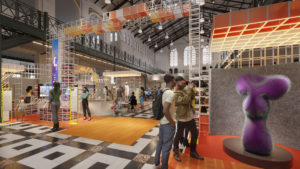
Futures that Inspire of FUTURES in the North Hall of the Arts + Industries Building, rendering, Courtesy of Rockwell group.
Neil Koenig Senior TV Series Producer: [00:23:20] Going back to the sort of interactivity that will be a big part of this exhibition, do you see this as a perhaps part of a wider trend across the museum sector? There are still many museums where you know the art, or the exhibits are cordoned off. Everyone speaks in hushed tones and there’s a kind of feeling of remoteness. And I’m just wondering whether people might feel that it’s time for this to be these barriers to be broken down a little bit.
Rachel Goslins, Director, AIB at the Smithsonian Institution: [00:23:57] Yeah, I think that’s quite astute. I think it’s true that there are still museums that feel a lot like that. There’s also a lot of museums that are really trying to experiment with ways to make their content more engaging, more interactive, more accessible. Everybody is challenged by really two things. One is budget, right? These things, these kinds of experiments can be quite expensive. And to, quite frankly, just the pace of technology, especially for museums, which are not known for moving at lightning speed is bewildering. You know, this is the thing this year and two years later, it’s VR. And then two years later, it’s AR and you’ve spent two years developing one kind of interactive. And by the time you put it on the floor, it feels outdated. So, I think all of those are challenges for museums. I have been heartened as I looked across, as I see across the spectrum about all the different, interesting ways that museums are trying to use digital technologies and new ways of storytelling to reach people. We have the luxury, because this is a temporary exhibition because it doesn’t have to last for 30 years and because we’re not bound by any particular discipline or collection to be able to experiment. And I hope that’s part of the value we’re providing to the Smithsonian, where some of our larger sister museums, it would take them a long time and be hard for them to mobilize around some of these more interesting and experimental uses of technology for visitor engagement. We’re able to do it kind of quicker and probably not as well. And some of them won’t work or will fail. But we’re able because of the way this exhibition is positioned, we’re able to be kind of an incubator for crazy ideas about visitor engagement and interaction. And some of those hopefully will become things that the Smithsonian and other museums can scale.
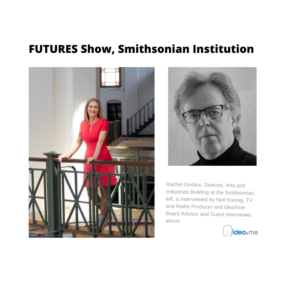
Neil Koenig Senior TV Series Producer: [00:25:57] Whilst you’ve been planning this exhibition, the pandemic was unleashed on the world, and everybody is now perhaps thinking differently about the present and the near future. How would you like the audience to approach the show and what do you hope that they’ll get out of it?
Rachel Goslins, Director, AIB at the Smithsonian Institution: [00:26:23] So that’s a great question. Yes, in my litany of why this was an impossible project, or a crazy project, an impossible subject in a broken building, in a large bureaucratic institution with very little time or money. And then the pandemic came. So, let’s just raise the degree of difficulty. And in response to that, I mean, it really was. We took a pause for about six months. We reframe we had to just sort of rethink of logistics and schedule differently. We were scheduled to open last spring, two years ago and we started this, so we reframed that. But we also used that opportunity, our curators use that opportunity to delve more deeply into our health content, into our social justice and equity content, to look at the technologies we were using to make sure that they were going to feel safe to people in a post-COVID environment. So, it was actually a great opportunity to go deeper and to winnow sort of separate the wheat from the chaff in the exhibition and make sure that what we were talking about was what was most essential. The question about how I want people to approach this exhibition is a good one.
An Invitation to Imagine the Future
Rachel Goslins, Director, AIB at the Smithsonian Institution: [00:27:34] I mean, I want it to be amazing. I want them to talk about it for the rest of their lives. I want them to approach it with a spirit of fun and adventure and a lightness. But mostly, I think I would ask them to set down for a moment, if they can, all of their, all of our anxieties about the planet about our society about the future for our children and our grandchildren, not forget them, not ignore them, but to set down for a moment all anxiety and walk into this exhibition with an open mind about what could go right and approach this exhibition with the spirit of what it is, which is an invitation to imagine the future you want for you, for future generations and to sort of joyfully, at least for the hour to that you’re wandering through the exhibition being delighted by robots and flying cars, but contemporary art and social experiments. To lean into the opportunity to just imagine a future that works for us all.
Neil Koenig Senior TV Series Producer: [00:28:57] Rachel Goslins, thank you very much.
Rachel Goslins, Director, AIB at the Smithsonian Institution: [00:29:00] Thank you so much, Neil. This has been really fun.
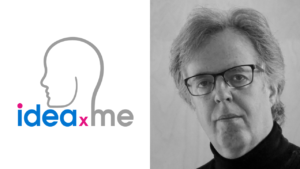
Credits: Neil Koenig, interview audio, video and text.
If you enjoyed this interview, you might also enjoy our interview with David Grinspoon, astrobiologist and author of Earth in Human Hands.
Watch: Visit ideaXme’s YouTube channel to subscribe.
Listen:
ideaXme is a global network – podcast on 12 platforms, 40 countries, mentor programme and creator series. Mission: To share knowledge of the future. Our passion: Rich Connectedness™!

